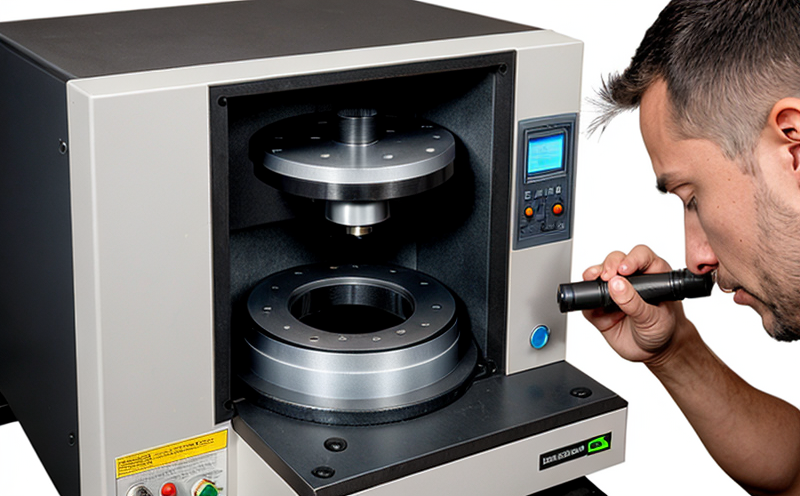ASTM E18 Rockwell Hardness with Metallographic Analysis
The ASTM E18 Rockwell hardness testing method is a widely recognized technique used to evaluate the hardness of materials. When combined with metallographic analysis, this test provides comprehensive insights into both the mechanical properties and microstructural characteristics of metallic materials. This service ensures compliance with industry standards while offering detailed metallurgical information that supports quality assurance programs.
In additive manufacturing (AM) processes such as laser powder bed fusion (LPBF), electron beam melting (EBM), or direct metal laser sintering (DMLS), the microstructure and hardness of materials play crucial roles in determining the final part's performance. For instance, in LPBF, the cooling rate significantly influences the grain size and distribution within a material. A finer-grained structure generally correlates with higher strength but may reduce ductility. Understanding these relationships through ASTM E18 Rockwell hardness combined with metallographic analysis helps optimize process parameters to achieve desired mechanical properties.
The testing involves several steps starting from sample preparation. Specimens are typically prepared by cutting or grinding small sections of the part into standard shapes (e.g., cylinders). These samples must be polished down to a fine finish, usually between 1-2 μm Ra, ensuring consistent surface conditions for accurate hardness readings. After polishing, metallographic examination may involve etching techniques like Kroll's reagent or FeCl3 solution to reveal crystal structures and grain boundaries.
The Rockwell hardness testing machine applies a predefined load incrementally onto the sample using a diamond indenter (type C is commonly used for metals). The indentation depth is measured, and based on this value, an appropriate Rockwell hardness number is assigned. This process can be automated with modern instruments that provide precise control over loading cycles.
Metallographic analysis complements this by examining the microstructure under high magnification (typically 100x to 500x). Micrographs captured during this step are crucial for identifying various phases present in the material, assessing grain size distribution, and evaluating any potential defects or porosity. By integrating these two methodologies, customers receive a more holistic view of their materials' properties.
Compliance with relevant standards is paramount when performing ASTM E18 Rockwell hardness tests. According to ASTM E18-23a, the standard practice for indentation hardness testing, there are specific guidelines regarding sample preparation, operator training, and instrument calibration which must be adhered to ensure accurate results.
For R&D teams looking into new alloys or process modifications, this service allows them to quickly identify areas needing improvement. It also serves as an essential tool during quality control checks ensuring consistency across batches produced using different raw materials or processing conditions.
Applied Standards
The ASTM E18 Rockwell hardness test adheres strictly to the guidelines outlined in ASTM E18-23a, which specifies practices for indentation hardness testing. This standard ensures that all tests conducted are consistent with internationally recognized procedures. Additionally, metallographic analysis follows methods prescribed by ASTM E407-19 regarding the preparation and examination of metals and alloys.
For additive manufacturing applications, it's important to note that some sectors may have additional specific requirements beyond general ASTM standards. For example, aerospace parts often follow AS 5526, which mandates stringent quality controls including multiple hardness checks throughout production processes. Similarly, automotive industry guidelines might require particular attention towards heat treat schedules and final inspections.
By aligning our testing protocols with these rigorous specifications, we guarantee that every report generated meets the highest levels of accuracy and reliability expected by our clients.
Why Choose This Test
The ASTM E18 Rockwell hardness test paired with metallographic analysis offers several advantages over other forms of material characterization. Firstly, it provides quantitative data on how hard a given material is, which directly impacts its suitability for various applications ranging from tool manufacturing to medical implants.
Secondly, by examining the microstructure alongside measuring hardness values, this service gives deeper insights into why certain materials behave in particular ways under different conditions. This knowledge can be invaluable when troubleshooting issues or optimizing future designs.
Thirdly, regulatory compliance is a key consideration for many organizations operating within strict industry standards. By adhering closely to ASTM E18 and associated metallography practices, our service ensures that all reports produced are fully compliant with relevant regulations, thus minimizing risks associated with non-conformity.
Lastly, the combination of these two tests offers a more comprehensive evaluation compared to standalone methods like simple tensile testing or visual inspection alone. Together they offer a balanced approach between strength metrics and microstructural details, providing a holistic understanding of material behavior.
Quality and Reliability Assurance
Our commitment to quality extends beyond just performing the test; it encompasses every aspect from initial consultation through final reporting. Our team consists of highly trained professionals who understand not only the technical aspects but also the broader implications these tests have on product development.
We employ state-of-the-art equipment calibrated according to manufacturer specifications and regularly verified against national standards. This ensures that all measurements are precise and reliable, providing confidence in our findings.
Each specimen is handled carefully from receipt through testing, ensuring minimal handling effects that could skew results. After analysis, detailed reports are generated which include not only the hardness values but also interpretive comments based on observed microstructures. These insights help guide further actions needed to meet specified criteria or improve overall performance.
In addition to these technical measures, we maintain strict internal controls and undergo regular external audits to ensure continuous improvement in our services. Our goal is always to exceed expectations by delivering accurate, reliable results that contribute positively towards your organization's goals.





